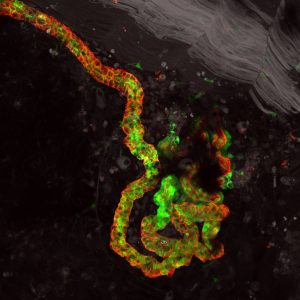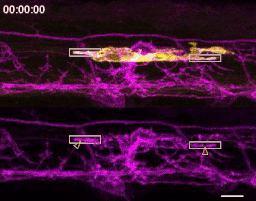Building plant weapons
Posted by Vivian Irish, on 27 July 2020
By Fei Zhang and Vivian F. Irish
Flowering plants, from giant sequoias to miniscule duckweed, all depend on the action of small populations of cells, called meristems, to grow. Meristems contain stem cells that continue to proliferate to give rise to roots, shoots, leaves, and branches. However, there are situations in which meristematic cells cease their proliferative activity and terminally differentiate; this occurs in flowers, and floral specific gene networks have been identified that terminate stem cell activity as flower development ensues. A far less well studied example of meristem termination is the formation of thorns. A number of plant species equip themselves with thorns to deter herbivores yet little is known of how these weapons are made.
Over ten years ago, our group set out to understand how meristematic activity is arrested during thorn development. Citrus was selected as a model for thorn development for two reasons: agronomic importance and feasibility. Citrus is one of the most economically valuable fruit crops in the world, and thornlessness is a breeding target as thorns affect fruit harvesting efficiency and can physically damage fruits. In addition, research in citrus is practical: the genome sequences of several citrus species are available, there are naturally occurring citrus variants that lack thorns, and citrus is amenable to genetic transformation. As tractable mutants are key for functional genetics studies, we established a fast and efficient citrus genome editing system by using the YAO promoter to drive Cas9 expression and employed heat stress treatments to further increase CRISPR-mediated gene editing efficiency. This system has proven to be very effective and we can now inactivate up to six genes simultaneously in primary citrus transformants in just a few months.
In our recent paper, Zhang et al 2020, we first characterized thorn growth and defined stages from primordium initiation to terminal differentiation. At early stages, the thorn primordia appear dome-shaped, like that of typical shoot meristems. By stage 7, the thorn tip narrows and at stage 8, thorns elongate and become pointed. Furthermore, the expression of two meristem-expressed genes, SHOOT MERISTEMLESS (STM) and WUSCHEL (WUS) are downregulated at stage 8, with STM expression becoming confined to vascular tissues and WUS expression becoming undetectable. Cell division completely ceases by stage 13, and the thorn lignifies to produce the sharp hard stiletto-like tip.
The question that naturally arises is what terminates thorn meristem gene expression at stage 8. Using a thornless Mexican lime natural variant in comparison to normal Mexican limes, we performed transcriptome analyses of young shoots. We focused on differentially expressed transcription factors that are expressed preferentially in young thorns. One candidate gene, THORN IDENTITY1, encodes a TCP transcription factor, and its homologues control bud dormancy in other plant species and so was an excellent candidate for further analyses. Interestingly, TI1 expression starts at stage 8, and a CRISPR-induced mutation of TI1 leads to the transformation of some thorns into branches. TI1 has a paralogue in citrus, TI2, whose expression in thorns starts from stage 7, and a ti2 mutation also shows the thorn transformed into branch phenotype. Mutation of TI1 and TI2 together transforms nearly every thorn into a branch, resulting in a very bushy phenotype (Figure 1).

WUS expression is upregulated in ti1, ti2 and ti1ti2 mutants, suggesting that the TI genes may function through repressing WUS transcription. Supporting this, both TI1 and TI2 repress WUS promoter activity in transient expression assays, and TI1 directly binds to the WUS promoter as demonstrated by both chromatin immunoprecipitation and gel shift assays. Interestingly, the citrus WUS promoter has a TCP consensus binding site that is not present in the model plant Arabidopsis thaliana, and we showed that mutation of this cis-element can abolish TI1-WUS promoter regulation. Finally, disruption of the TI1–WUS pathway by either ectopic expression of WUS or via a WUS promoter mutation affects thorn development, indicating that this pathway is critical for thorn growth.
In the classic textbook “Patterns in Plant Development”, by Taylor Steeves and Ian Sussex, thorns are viewed as “one of the most striking departures from typical shoot morphology”. Our work serves as a first step for understanding how such evolutionary novelties arise. With the identification of citrus thorn identity TI genes and a previously undescribed TI–WUS pathway for stem cell regulation, we now have a handle to explore the upstream and downstream regulators involved in weaponizing plants. It is also worth mentioning that thorns have evolved multiple times, and can exhibit very striking departures from shoots, for instance as in honey locust thorns (Figure 2). It still remains to be seen if different plant species redeploy the TI-WUS pathway for thorn development, or if different species armor themselves in unique ways.



 (2 votes)
(2 votes) (No Ratings Yet)
(No Ratings Yet)




